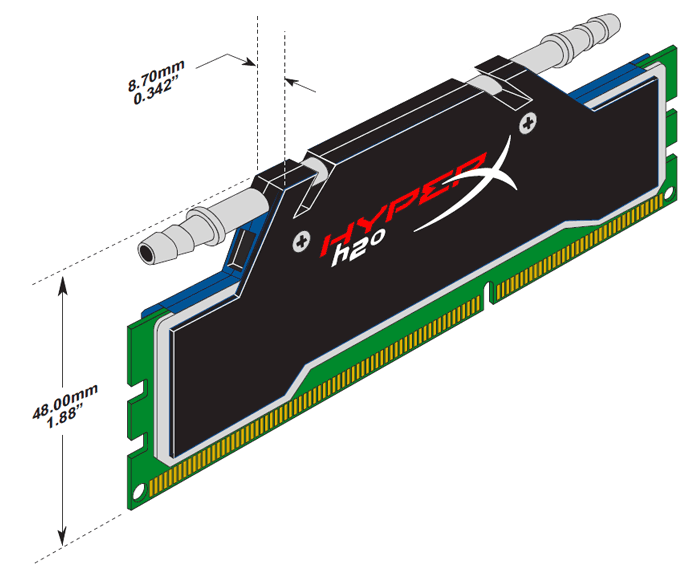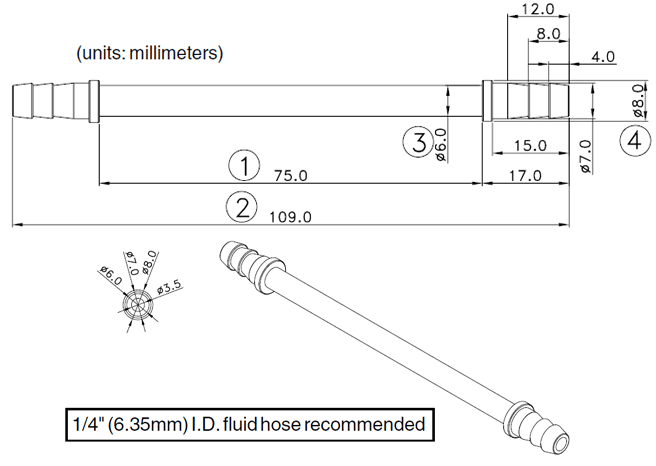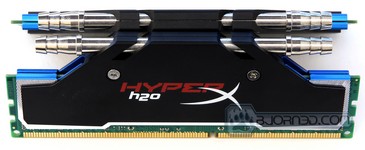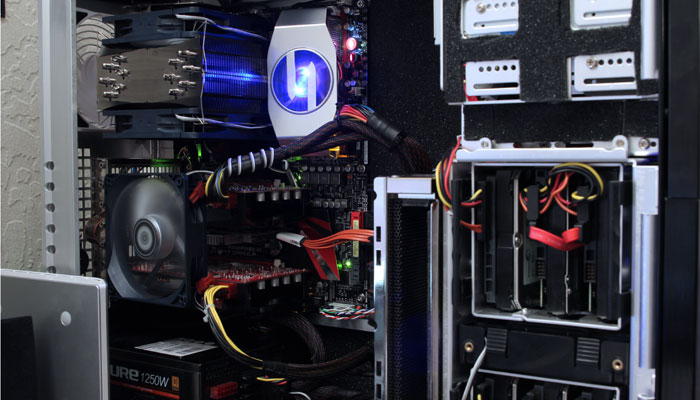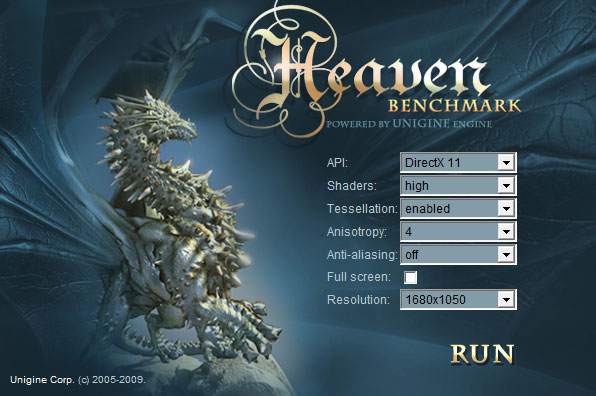The Kingston H2O 2133MHz 4GB Dual-Channel KHX2133C9AD3W1K2/4GX memory kit is designed for users looking for high performance in their applications and also be able to overclock their memories with the help of Kingston’s water cooled heatsink design.
Introduction
Higher memory speed is always an advantage when it comes to getting the most out of memory intensive applications such as video editing and compositing applications, 3D designing software, or even video games. Users working with overclocking also find a high demand for fast memory and try to push their kits even further than stock settings. To ensure that the memory is stable during high frequencies, there also needs to be a good cooling solution present. This is why Kingston decided to implement a water cooling solution on their new dual-channel HyperX H2O DDR3 4GB 2133MHz KHX2133C9AD3W1K2/4GX memory kit.
It is the user’s option to choose between water cooling or air cooling, and the HyperX H2O memory kit is designed to be used with or without water cooling, so the end-user does not have to limit their options to a full water cooling loop just because the memory was designed with a water cooled heatsink design. The water cooling design Kingston uses on their HyperX H2O series memory kit also doubles as the standard heat spreader that all other high-end memory modules come with. Most other sites test this kit with water cooling, but with Kingston’s approval, we’re going to test it without water cooling. We’ll see how the memory performs with simple air circulation, and also see how far we can push the H2O memory kit without using water.
Kingston’s HyperX H20 KHX2133C9AD3W1K2/4GX is a kit of two 256M x 64-bit 2GB (2048MB) memory modules, based on sixteen 128M x 8-bit DDR3 FBGA components per module. The timing on this specific kit is 9-11-9-27 with a 1T command rate. The HyperX H2O kit also comes with two Intel XMP (Extreme Memory Profiles) enabling the user to switch between the possible DDR3-2000 and DDR3-2133 and one other lower specification depending on compatibility and stability of the motherboard, and processor. Because some locked processors may not have such a good memory compatibility, especially in the higher frequency ranges, the user can take advantage of the lower frequencies in the XMP.
FEATURES:
- JEDEC standard 1.5V ± 0.075V Power Supply
- VDDQ = 1.5V ± 0.075V
- 667MHz fCK for 1333Mb/sec/pin
- 8 independent internal bank
- Programmable CAS Latency: 5,6,7,8,9,10
- Posted CAS
- Programmable Additive Latency: 0, CL – 2, or CL – 1 clock
- Programmable CAS Write Latency(CWL) = 7(DDR3-1333)
- 8-bit pre-fetch
- Burst Length: 8 (Interleave without any limit, sequential with starting address “000” only), 4 with tCCD = 4
- which does not allow seamless read or write
- Bi-directional Differential Data Strobe
- Internal(self) calibration : Internal self calibration through ZQ pin (RZQ : 240 ohm ± 1%)
- On Die Termination using ODT pin
- Average Refresh Period 7.8us at lower then TCASE 85°C, 3.9us at 85°C < TCASE . 95°C
- Asynchronous Reset
- PCB : Height 1.88” (48.00mm) w/ heatsink, double sided component
PERFORMANCE:
- CL(IDD) 9 cycles
- Row Cycle Time (tRCmin) 49.5ns (min.)
- Refresh to Active/Refresh Command Time (tRFCmin) 110ns
- Row Active Time (tRASmin) 36ns (min.)
- Power 1.800 W (operating per module)
- UL Rating 94 V – 0
- Operating Temperature 0o C to 85o C
- Storage Temperature -55o C to +100o C
Module Dimensions:
Module With Heatsink:
Cooling Tube Dimensions:
Memory Timings Explained
Memory timings can be very confusing, so we are explaining them here before continuing on. Let’s start off with the numbers we usually see on a memory DIMM’s sticker: the timings. Memory timings are what ultimately decide how far a memory DIMM will overclock and perform. The lower number(s) the timings are, the better performance the memory modules will get. A 9-9-9-24 rated timing kit is a common timing on affordable DDR3 memory kits. Anything below those common timings will result in a higher price tag due to faster performance. So what do those numbers really mean? First, we need to explain what numbers relate and correspond to.
There are four main timings that heavily effect memory performance:
CAS Latency (tCL), RAS to CAS Delay (tRCD), Row Precharge Time (tRP), and RAS Active Time (tRAS).
For this explanation, we will use the Kingston HyperX KHX2133C9AD3W1K2/4GX DDR3 2133MHz memory module’s, 9-11-9-27 timings.
CAS Latency Time (tCL) 9-11-9-27
CAS stands for Column Address Strobe. Latency is the amount of time taken to respond. The lower the CAS Latency value, the faster the memory controller and modules communicate. The memory controller communicates with individual modules on the DIMM’s requesting data in cycles.
RAS to CAS Delay Time (tRCD) 9-11-9-27
RAS stands for Row Address Strobe and CAS stands for Column Address Strobe. The RAS to CAS Delay value is the amount of time in cycles it takes to perform a task requested by the memory controller.
Row Precharge Time (tRP) 9-11-9-27
The Row Precharge value is the amount of time in cycles needed for the Row Address Strobe (RAS) to collect before another row can be utilized. This acts almost like a queue in a sense.
RAS Active Time (tRAS) 9-11-9-27
RAS stands for Row Address Strobe. RAS Active Time is the amount of time (in cycles) between a row being occupied by Row Precharge (tRP) and unoccupied.
All timings are measured in nanoseconds (ns). The lower the value for each timing, the faster the memory modules can work together and report back whatever was requested from the memory controller/processor.
Pictures & Impressions
Finally, the Kingston HyperX H20 kit is designed to fit 1/4″ (6.35mm) tubing. Those who use larger tubing will have to use converters that will convert larger tubing to 1/4″ tubing. As mentioned earlier in the introduction, we are not going to be water cooling this memory kit, because we want to see how it will perform without any water cooling.
Testing Methodology
We’ve expanded our testing suite considerably for the X58 chipset, and will continue to use the same methods for most of the motherboards and CPU’s we test. In the interests of thoroughness and accurate results, we run each test at least three times, and some tests more than that. We average the total of all the tests from each benchmark then report the average here.
The OS we use is Windows 7 Pro 64bit with all patches and updates applied. We also use the latest drivers available for the motherboard and any devices attached to the computer. We do not disable background tasks or tweak the OS or system in any way. We turn off drive indexing and daily defragging. We also turn off Prefetch and Superfetch. This is not an attempt to produce bigger benchmark numbers. Drive indexing and defragging can interfere with testing and produce confusing numbers. If a test were to be run while a drive was being indexed or defragged, and then the same test was later run when these processes were off, the two results would be contradictory and erroneous. As we cannot control when defragging and indexing occur precisely enough to guarantee that they won’t interfere with testing, we opt to disable the features entirely.
Prefetch tries to predict what users will load the next time they boot the machine by caching the relevant files and storing them for later use. We want to learn how the program runs without any of the files being cached, and we disable it so that each test run we do not have to clear pre-fetch to get accurate numbers. Lastly we disable Superfetch. Superfetch loads often-used programs into the memory. It is one of the reasons that Windows Vista occupies so much memory. Vista fills the memory in an attempt to predict what users will load. Having one test run with files cached, and another test run with the files un-cached would result in inaccurate numbers. Again, since we can’t control its timings so precisely, it we turn it off. Because these four features can potentially interfere with benchmarking, and and are out of our control, we disable them. We do not disable anything else.
Test Rig
| Test Rig | |
| Case | Silverstone Temjin TJ10 |
| CPU |
Intel Core i7 930 @ 3.8GHz |
| Motherboard |
ASUS Rampage III Extreme ROG – LGA1366 |
| Ram |
Kingston HyperX H20 DDR3-17066 2133MHz (9-11-9-27 @ 1.65V) 4GB Dual-Channel Kit |
| CPU Cooler | Thermalright True Black 120 with 2x Zalman ZM-F3 FDB 120mm Fans |
| Hard Drives |
4x Seagate Cheetah 600GB 10K 6Gb/s Hard Drives 2x Western Digital RE3 1TB 7200RPM 3Gb/s Hard Drives |
| Optical | ASUS DVD-Burner |
| GPU |
2x Palit GTX460 Sonic Platinum 1GB GDDR5 Video Cards in SLI |
| Case Fans |
2x Zalman ZM-F3 FDB 120mm Fans – Top 1x Zalman Shark’s Fin ZM-SF3 120mm Fan – Back 1x Silverstone 120mm fan – Front 1x Zalman ZM-F3 FDB 120mm Fan – Hard Drive Compartment 1x Zalman ZM-F3 FDB 120mm Fan – Side Ventilation for Video Cards and RAID Card SAS Controller. |
| Additional Cards |
LSI 3ware SATA + SAS 9750-8i 6Gb/s RAID Card |
| PSU |
Sapphire PURE 1250W Modular Power Supply |
| Mouse | Logitech G5 |
| Keyboard | Logitech G15 |
Test Suite
We will use the following applications to test the performance of the memory kit. Benchmarks
| Benchmarks |
|---|
| Everest Ultimate Edition |
| SiSoft SANDRA 2010 |
| SuperPi |
| 3DMark Vantage |
| Unigine Heaven 2.1 |
| Crysis |
To test the memory kits thoroughly, we ran the kits through benchmarks to ensure stability and proper function. Everest Ultimate, SiSoft Sandra, and Super PI were used to stress both the system and the memory to test for stability and also result reporting. To monitor frequencies and timings, we used CPUID’s CPU-Z. We also added a few 3D applications to the benchmark to get some gaming results.
Overclocking
Unfortunately, we were unable to push the Kingston HyperX H20 DDR3-17066 2133MHz memory kit past it’s stock settings. Though the ASUS Rampage III Extreme motherboard can handle higher memory frequencies, and according to Kingston the KHX2133C9AD3W1K2/4GX kit is also capable of higher clock speeds, our tests indicate that our CPU is bottlenecking the memory speeds. We feel that the memory controller on the processor is not able to boot at higher clock speeds because once we pass the 2133MHz limit, the motherboard is reporting CPU problems when we boot our system. We recommend using unlocked CPUs to achieve higher frequencies on the H2O kit.
The following CPU-Z screenshot of the memory running at 2133MHz and the stock 9-11-9-27 1T timings was taken on the GIGAYBTE X58A-UD7 motherboard. However, we were able to achieve this speed with some stability on the ASUS Rampage III Extreme motherboard as well.
We used the ASUS Rampage III Extreme motherboard to benchmark the Kingston HyperX H2O 4GB DDR3 2133MHz Dual-Channel Memory Kit. We compared the HyperX kit to an OCZ Gold Series 4GB Dual-Channel DDR3 1600MHz kit. Here is a picture of the ASUS Rampage III Extreme running the Kingston HyperX H20 Memory Kit at 2133MHz with a Core i7 930 processor. We were lucky to reach 2133MHz with the Intel Core i7 930 processor. The QPI/DRAM voltage had to be set to 1.74V, which is way above Intel’s specifications in order to maintain stability at 2133MHz. The processor had to be overclocked past the 3.8GHz mark that we used for benchmarking when we ran at 2133MHz. Consequently, all the tests, except the ones at 2133MHz, were done at 3.8GHz.
Everest Ultimate Memory Suite

“EVEREST Ultimate Edition is an industry leading system diagnostics and benchmarking solution for enthusiasts PC users, based on the award-winning EVEREST Technology. During system optimizations and tweaking it provides essential system and overclock information, advanced hardware monitoring and diagnostics capabilities to check the effects of the applied settings. CPU, FPU and memory benchmarks are available to measure the actual system performance and compare it to previous states or other systems. Furthermore, complete software, operating system and security information makes EVEREST Ultimate Edition a comprehensive system diagnostics tool that offers a total of 100 pages of information about your PC.”

Everest Memory shows very clearly that the Kingston HyperX H2O at 2133MHz takes 1st place against the OCZ memory kit. We ran several other settings as well that would compare the OCZ and Kingston memory kits at the same timings and speed. The 2000MHz setting is the first XMP setting on the memory module that we wanted to test out. The higher MB/s transfer speeds in Read, Write and Copy show that applications that can take advantage of higher speed memory modules, such as Adobe After Effects CS4, will perform a lot faster with Kingston’s HyperX H2O kit than the OCZ Gold-Series kit.
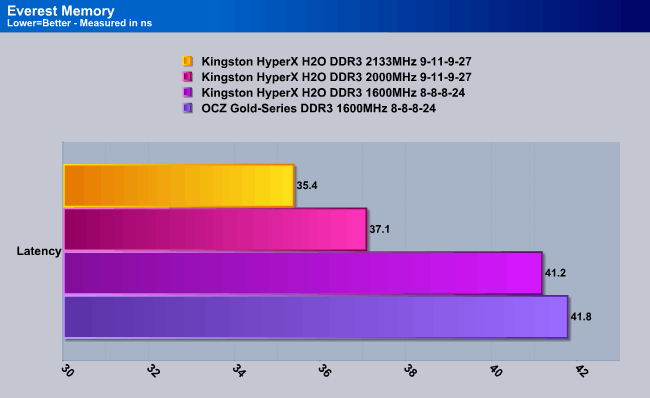
The latency is also very important at determining the performance in memory intensive applications. The lower the number, the better, because the the data that gets read or written to the memory will have a lot less waiting time in between. The Kingston HyperX H20 kit takes 1st place in latancy as well.
3DMark Vantage
For complete information on 3DMark Vantage Please follow this Link:
www.futuremark.com/benchmarks/3dmarkvantage/features/
The newest video benchmark from the gang at Futuremark. This utility is still a synthetic benchmark, but one that more closely reflects real world gaming performance. While it is not a perfect replacement for actual game benchmarks, it has its uses. We tested our cards at the ‘Performance’ setting.
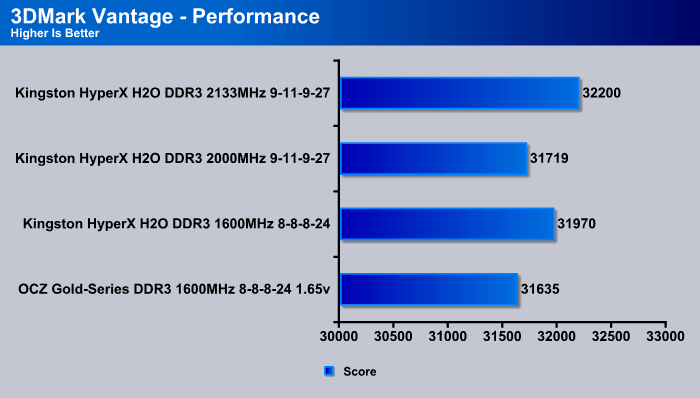
3DMark Vantage helps us see real-time performance that we would get in games. Higher scores indicate better performace. We can see that the Kingston HyperX H20 kit at the 2000MHz speed and 9-11-9-27 timings fell behind the 1600MHz 8-8-8-24 settings on the same memory module. This shows that the timings might be the cause of the drop in performance. Once the frequency of the H2O kit is increased to 2133MHz, the performance becomes much better, and faster than the 1600MHz frequency at 8-8-8-24 timings.
Sisoft Sandra 2010
“SiSoftware Sandra (the System Analyser, Diagnostic and Reporting Assistant) is an information & diagnostic utility. It should provide most of the information (including undocumented) you need to know about your hardware, software and other devices whether hardware or software. It works along the lines of other Windows utilities, however it tries to go beyond them and show you more of what’s really going on. Giving the user the ability to draw comparisons at both a high and low-level. You can get information about the CPU, chipset, video adapter, ports, printers, sound card, memory, network, Windows internals, AGP, PCI, PCI-X, PCIe (PCI Express), database, USB, USB2, 1394/Firewire, etc.”

Arithmetic calculation does not show much of an increase in performance when it comes to memory speed. The reason why the 2133MHz results are a bit higher than the 2000MHz results is because the processor speed was upped to 3.9GHz due to the locked CPU. The BCLK had to be changed to adjust to 2133MHz, which is why the CPU clock speed was also changed from 3.8GHz to 3.9GHz. That fact is crucial to understanding these results.
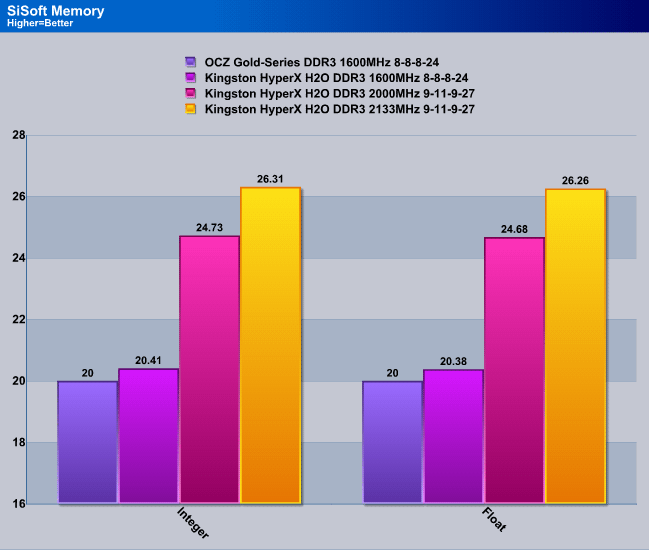
The SiSoft Sandra 2010 Memory test, however, showed that memory performance was a lot better at 2133MHz, and once again Kingston’s HyperX H2O memory kit took first place in the tests. The same understanding goes here as we explained in the Everest Ultimate Memory benchmarks.

The MultiMedia test once again pushes the CPU, however we were interested to see if the memory speed has any performance increase on the MultiMedia benchmark. The 2133MHz performance increase in the benchmarks is expected just like the Arithmetic benchmark has shown, due to the CPU performance being increased from 3.8GHz to 3.9GHz.
Super Pi

“Super PI is the “Gold standard” for many when it comes to judging system performance. We ran the 4 Meg calculation, again running each test three times and reporting the average of the results.”
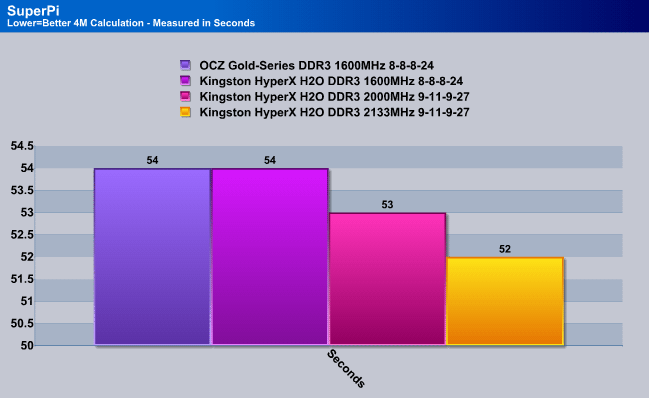
SuperPi is an application that overclockers use to compete against other overclockers around the world. When it comes to overclocking, having a high-performance memory module is very important to achieve extreme clock speeds on the CPU. Even though the CPU speed has not changed from the memory modules being set at 1600MHz and 2000MHz, there was a 1 second performance increase just because the memory was operating at a higher frequency.
Unigine Heaven 2.1
Unigine Heaven is a benchmark program based on Unigine Corp’s latest engine, Unigine. The engine features DirectX 11, Hardware tessellation, DirectCompute, and Shader Model 5.0. All of these new technologies combined with the ability to run each card through the same exact test means this benchmark should be in our arsenal for a long time.

This is where it becomes interesting. Extreme gamers play games at resolutions of 1920×1080 or higher, which is what we have tested our games on. Had we tested the games at 800×640 or 1024×768 resolutions, the performance of the memory modules would have been clearly visible. However, extreme gamers play games at higher resolutions, so it is ideal to test the memory on high resolutions since it was designed for extreme gamers. From the benchmarks, we noticed that there is absolutely no performance increase that would be noticible if users would have a higher frequency memory.
Crysis v. 1.21
Crysis is the most highly anticipated game to hit the market in the last several years. Crysis is based on the CryENGINE™ 2 developed by Crytek. The CryENGINE™ 2 offers real time editing, bump mapping, dynamic lights, network system, integrated physics system, shaders, shadows, and a dynamic music system, just to name a few of the state-of-the-art features that are incorporated into Crysis. As one might expect with this number of features, the game is extremely demanding of system resources, especially the GPU. We expect Crysis to be a primary gaming benchmark for many years to come.

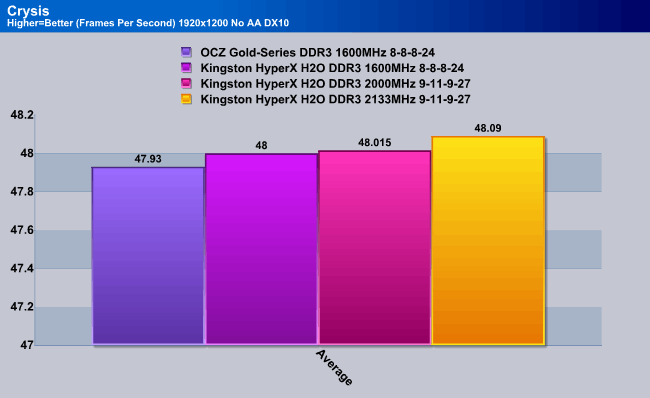
Exactly the same results were seen in Crysis when we compared memory frequencies. Performance increase is so minimal, a gamer at higher resolutions would not be able to notice the performance increase. In our opinion, buyers should stay away from this memory if they only want to use it for performance gaming, because the increase is unnoticeable at high resolutions. On the other hand, for buyers who are planning on memory intensive applications like video editing and compositing, a higher memory frequency will help tremendously.
Temperatures
To measure the idle temperature, we let the computer idle for half an hour on the Windows desktop, and recorded the memory temperature. Then we ran Adobe After Effects CS5 and rendered a large, high-definition video file for 10 minutes, using an average 95% of the memory. We then recorded that as the load temperature.
| Temperatures of the DIMMs – Ambient Temperature 23C | |
|---|---|
|
OCZ Gold-Series 4GB DDR3 1600MHz 8-8-8-24 2T |
Idle: 32C, Load: 43C |
|
Kingston HyperX H2O 4GB DDR3 2133MHz 9-11-9-27 1T |
Idle: 30C, Load: 40C |
It is very interesting to see that the Kingston kit had lower temperatures than the OCZ Gold-Series memory modules. The reason for this is that the Kingston HyperX H2O kit is running at 2133MHz while the OCZ is only at 1600MHz. This could yet be another fact that proves that the quality of the heatspreader on the HyperX H20 series memory modules is excellent. It also makes sense because the HyperX H20 memory modules have a larger heat spreader than the OCZ Gold-Series modules.
Conclusion
Does the new Kingston HyperX H20 KHX2133C9AD3W1K2/4GX memory kit really need a water cooling setup to operate properly? No, we don’t see the reason why water cooling a memory would be necessary besides pushing the memory kit to its limits beyond the stock settings. We do think that it would look quite impressive, once the water loop is set up. The problem we have with the design of the water cooling is that once the person decides to double the amount of memory they have, they will have to come up with another way of connecting the tubes to their water cooled heatsink on the memory, because having so many tubes in one location makes it difficult to route the tubing to avoid kinks. One thing Kingston should have thought about when they were designing the heatsink on the H2O kit was a separate heatsink design which would have the tubing come in from the top instead of the side. This would allow the user to switch between the side and top tubing design and have an easier time connecting the loops without having to worry about whether it would fit. Of course there are options out there that can bypass this problem, but in our opinion, there still might be some clearance issues because the memory slots are so close to each other. Kingston had the following to say about this problem: “We designed the piping to run the length of the memory was because we were afraid that in some system builds, the pipes could get bent if they impeded on other components.” Users who choose to water cool their memory will most likely choose to water cool their processor and motherboard as well. This means that there should be no motherboard/processor coolers in the way. A video card, however, could extend far enough that it would obstruct the side tubing on the memory modules.
The Kingston H2O 4GB Dual-Channel DDR3 KHX2133C9AD3W1K2/4GX memory kit is very fast compared to our OCZ memory module in applications that require quick read/write and copy speeds. An application perfectly suited for this memory is Adobe’s After Effects CS5, which requires tons of memory and high performance during rendering. While the overclocking potential of the H2O kit was limited by our processor, we do believe that it is possible to squeeze a bit more performance out of these memory modules with an unlocked CPU. Processors best suited for this include the Core i7-875K Lynnfield 2.94GHz LGA 1156 Quad-Core Processor, or for users who want a triple-channel H20 kit, the Core i7-975 Extreme Edition Bloomfield Quad-Core or i7-980X Extreme Edition Gulftown Six-Core processors.
Kingston states that the HyperX H2O series memory kits are designed for ‘Extreme Gamers’. By extreme we would assume users that perhaps run overclocked systems, and play games at high resolutions. As we tested the HyperX H2O kit compared to the 1600MHz OCZ memory, there was no noticeable difference in gaming performance. The 2133MHz HyperX H2O kit got about 0.1-0.2FPS higher scores, but is that really a difference that a user will notice during gaming? Probably not!
| OUR VERDICT: Kingston HyperX H20 4GB DDR3-17066 2133MHz Memory Kit | ||||||||||||||||||
|
||||||||||||||||||
| Summary: While according to our tests, we did not see performance increase in games for extreme users, we did see a high performance increase in memory intensive applications like Video Editing, and 3D modelling applications. With a total score of 8/10, the Kingston HyperX H20 KHX2133C9AD3W1K2/4GX 4GB DDR3-17066 2133MHz memory kit will receive the Bjorn3D Silver Bear Award. |
 Bjorn3D.com Bjorn3d.com – Satisfying Your Daily Tech Cravings Since 1996
Bjorn3D.com Bjorn3d.com – Satisfying Your Daily Tech Cravings Since 1996




